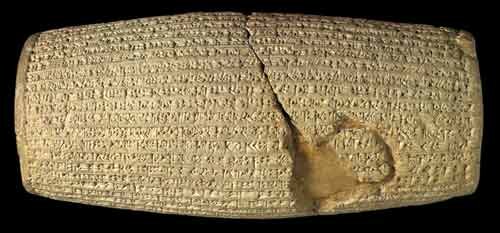|
News | Iran Travels | Iran Professional Services | About | Contact | Discussion Forum | Archive |
|
HAMSAYEH.NET |
| IRAN & INTERNATIONAL NEWS | CONTACT | ABOUT |
|
|
Original Cyrus Cylinder On Display at Iran's National Museum | ||
|
|
|||
|
Original Cyrus Cylinder is on display at Iran's National Museum on a four-month loan by the British Museum
Tehran, September 12, 2010 (Hamsayeh.Net) - After some years negotiations finally the British Museum delivered one of history’s most unique artifacts dating back over 25 centuries, the Cyrus Cylinder, to Iran to be displayed at the National Museum of Iran for a period of four months. Iran’s National Museum curator Azadeh Ardakani told IRNA, ‘The British Museum had previously said that it was ready to send the Cyrus Cylinder to Iran, but the National Museum of Iran had to make the necessary arrangements for transport of the artifact.’ On Friday British Museum curator John Curtis delivered the cylinder personally to Iran handing it over to his Iranian counterpart. Measuring approximately 22.5 centimeters (8.9 in) x 10 centimeters (3.9 in) in size, the clay cylinder is considered the first written instance of human rights declaration in history though that may differ from our modern, more individualistic interpretation of what constitute human rights. Cyrus the Great King of Persia between 576 to 530 BC is well remembered as history’s first major ruler who unlike his predecessors acted benevolently. Where it was customary to impose harsh conditions on subject people particularly on war prisoners, captured or surrendered after battles of conquest, Cyrus the Great issued verdicts to safeguard lives and livelihoods of people he conquered.. The cylinder is written in Akkadian cuneiform script and explains the way the Persian ruler treated various groups of people when he entered Babylon in 539 BC. Following is part of the translated text written in original cuneiform: From … to Aššur and [from] Susa, Agade, Ešnunna, Zamban, Me-Turnu, Der, as far as the region of Gutium, the sacred centers on the other side of the Tigris, whose sanctuaries had been abandoned for a long time, I returned the images of the gods, who had resided there [i.e., in Babylon], to their places and I let them dwell in eternal abodes. I gathered all their inhabitants and returned to them their dwellings. (Source Wikipedia)
|
|
||
Disclaimer: Opinions expressed on this site are solely Hamsayeh.Net’s own and do not represent any official institutions’, bodies’, organizations’ etc.
Similarly, Hamsayeh.Net would not be responsible for any other opinions that may be expressed therein by other sources through direct or indirect quotations.


